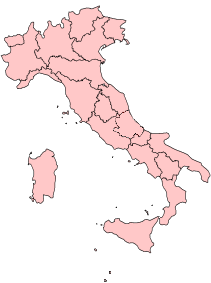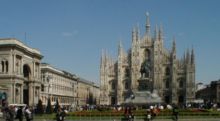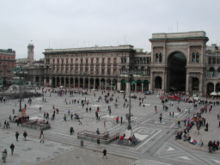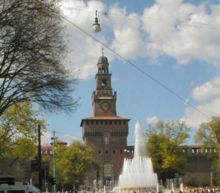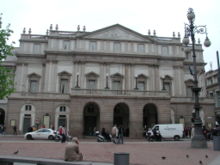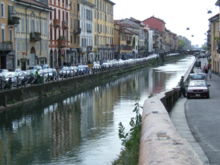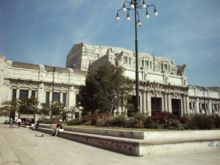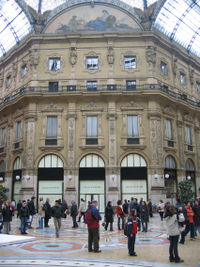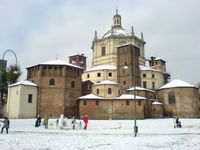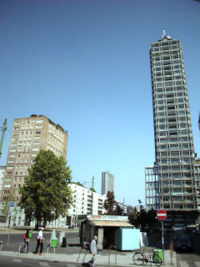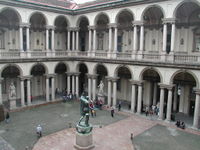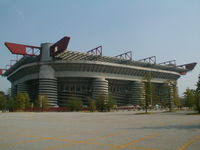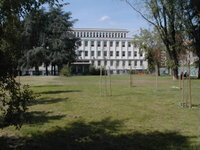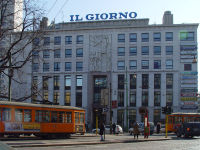Milan
2007 Schools Wikipedia Selection. Related subjects: European Geography
| Comune di Milano | |
|---|---|
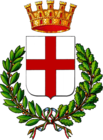 Municipal coat of arms |
|
| Country | |
| Region | Lombardy |
| Province | Milan (MI) |
| Mayor | Letizia Moratti |
| Elevation | 120 m |
| Area | 182 km² |
| Population | |
| - Total (as of December 31, 2004) | 1,308,311 |
| - Density | 6,988/km² |
| Time zone | CET, UTC+1 |
| Coordinates | |
| Gentilic | Milanesi or Meneghini |
| Dialing code | 02 |
| Postal code | 20100, 20121-20162 |
| Patron | St. Ambrose |
| - Day | December 7 |
|
|
|
| Website: www.comune.milano.it | |
Milan ( Italian: Milano; Milanese: Milán (listen)) is the main city of northern Italy, located in the plains of Lombardy. The city proper (Comune di Milano) has about 1,308,500 inhabitants (2004). The population of the urban area ( Greater Milan La Grande Milano), comprising the core of Lombardy, is estimated, as of 2006, to be about 4,280,820 people.
In European terms, Milan's metropolitan area is a part of the so called Padan Megalopolis. By population, Milan is Italy's largest city and the 3rd Metro Area of the EU. Municipal borders wrap a relatively small area—about one-eighth that of Rome—because of the historical high density of population centers in agriculturally rich Lombardy. The heavily urbanized area centered in Milan includes some Swiss territories in southern Canton Ticino: this does not imply any kind of administrative unity, though. Milan is an alpha world full service city in GaWc inventory.
Milan's province (due to be dissolved sooner or later into the Metropolitan City, a new administrative unit not yet implemented) lies in the western part of Lombardy; it covers an area of 1,981 square kilometers and has a population of 3,839,216 (2005); in 1991, the population was 3,738,685. The province comprises 188 communes, ranging in population (2001) from Milan (1,308,311) to Nosate (638); between 1991 to 2001, the city of Milan has lost 113,084 inhabitants (8.3 percent) mostly due to suburban sprawl and expulsion of population from the inner city centre, which is now almost fully dedicated to offices and commerce. On November 2006 for the first time was certificated the official population of Milan Metro Area, in an area of more than 9,000 square kilometers, live 7,4 Millions.
The city is one of the world's major commercial and financial centers, and one of the wealthiest cities in the European Union. Milan is one of the world capitals of fashion — along with New York City, Paris, London, Tokyo— and design. Indeed the English word milliner is derived from the name of the city. The Lombard metropolis is famous for fashion firms and shops ( via Montenapoleone) and the Galleria Vittorio Emanuele in the Piazza Duomo, reputed to be the world's oldest shopping mall. Another famed Milanese product is the traditional Christmas sweet cake, called Panettone. Milan is also famous for the Alfa Romeo motorcar and for its silk production; but on the whole relies on its directional functions for the whole of Lombardy, its once proud and strong industrial base having been externalized throughout the region in the 60s-70s of the last century. The city hosted among other events the World Exposition in 1906, the football World Cup in 1934 and 1990, the football Euro Cup in 1980, and plans to host the World Expo of 2015.
Inhabitants of Milan are referred to as "Milanese" (Italian: Milanesi or informally Meneghini or Ambrosiani).
Name
Milan's name comes from the Celtic Medelhan, meaning "in the middle of the plain", due either to its location in a plain close to the confluence of two small rivers, the Olona and the Seveso, or perhaps to its being close to, and roughly equidistant from, two major rivers, the Ticino and the Adda. Its Latin name, Mediolanum, roughly meaning "wool in the middle", also built on Celtic lore: Celts saw the boar as a mythical animal and according to a prophecy the site for the settlement would have been indicated to a Celtic king by the appearance of a wild pig or boar with a ridge of hair along its back, as reported by Cardano around 1626:
- Nel fabricar de le superbe mura
- De la prima Città ch'abbian gl'Insubri
- Uscì da i fondamenti un gran Cinghiale,
- Mezzo di pel setoso, e mezzo ignudo,
- Onde MILAN chiamossi
- Da gli Hedui, o Borgognoni, o pur da i Franchi,
- Da cui l'origine hebbe,
- Che altri di MEZZA LANA dir potrebbe
- De la prima Città ch'abbian gl'Insubri
Translated:
- While building the majestic wall
- Of the first Town of Insubres
- From the foundation a big boar came
- Half with silk hair, and half bare
- Therefore MILAN was called
- From Hedui, or Burgundians or even from Franks
- From which the origin came
- That other could call of half wool
- Of the first Town of Insubres
Today the boar is still sometimes used as a symbol of the city. According to another explanation, Mediolanum comes from a corruption of In medio lanorum meaning between the rivers - actually Milan still includes the two small Olona and Seveso rivers.
The German name for the city is Mailand, while in the local Western Lombard dialect, the city's name is Milán, pronounced quite as in French.
History
It is presumed Milan was originally founded by the Celts of Northern Italy around 600 BC and was conquered around 222 BC by the Romans, who gave it the name of Mediolanum. In the 4th century, at the time of the bishop Saint Ambrose and Emperor Theodosius I, the city was briefly the capital of the Western Roman Empire. At that time Milan was the second largest city in Europe, with more than 300,000 inhabitants. St Ambrose is now the Patron Saint of the city. With the Visigoth menace mounting, Milan lost its capital role to Ravenna in 402. Attila plundered the city in 452 during his invasion of Italy, then the Ostrogoths of Uraia ravaged it in 541, during the disastrous Greco-Gothic war. The ghost of a city was then taken by the Lombards in 569; the main Byzantine officials, both civilian and religious, fled to Genoa for safety. The Lombards made Milan capital of one of their main duchies, and the city slowly but surely recovered a role, if overshadowed by neighbouring Pavia and Monza.
11th century
In the eleventh century the city regained its importance and began to impose its power. Milan became a prosperous, if seldom quiet, comune. The eleventh century saw the birth and growth of several papal and church reform movements, such as the Peace and Truce of God and the Gregorian reforms. Milan itself, the powerful but corrupt church was put under siege by the reformers of the so-called pataria, a local movement led by both religious and secular figures. In the latter half of the century, Milan and its province suffered ecclesiastical schism and confusion as well as violence and war as the patarini struggled to reform the clergy. With peace and order attained in the early 1090s, Milan enterred the wider struggle between the power of the popes and the emperors. In the twelfth century, she led the other Italian cities in gaining semi-independence from the Holy Roman Empire in the wars of the Lombard League against Frederick Barbarossa, culminating in the glorious Battle of Legnano ( 1176). Thus, during the Middle Ages Milan became one of the most rich and powerful cities of Europe (due to its commerce and industries) conquering and influencing at times great part of northern Italy.
At the beginning of the 11th Century, Milan experienced several civil outbreaks. The main conflicts were between the Nobles and Plebeians. Therefore, a tripartite polity was formed, creating a compromise between the great nobles, lesser nobles, and plebeians, led by a podestà. There was also fighting between the Guelphs and Ghibellines, who supported the pope and emperor respectively. The ruling family of Milan, the Viscontis, supported the Ghibellines, and the emperor acknowledged Ottone Visconti as the Archbishop. The Visconti House went on to peacefully conquer Pavia, Piacenza, Bergamo, Brescia, and Parma. They gained support from their citizens by treating them charitably. In 1354, power fell into the hands of brothers Galeazzo and Bernab Visconti. Originally they split the city in two to share the power, but rejoined in 1359 to defeat Pavia. Pavia then became Galeazzo's city, where be built a university. When he died in 1387, he left his land to his son, Gian Galeazzo Visconti. However, Bernab was a different child. He ruled under strict laws, was threatened with excommunication, and became greedy after his brother's death. In 1385, when he attempted to take all the land back under one rule, Gian imprisoned him. Gian went on to be a powerful ruler, who expanded his empire arcoss northern Italy, gathering land as he went. The only northern city-state to avoid his conquest was Venice. He died from illness while trying to conquer Florence in 1402. His sons, Giovanni Maria Visconti and Filippo Maria Visconti split up the land, which then either became independent or was conquered by Venice. Giovanni became duke, but in 1412 was assassinated amid political controversy. Filippo had no sons, ending the Visconti line. He died in 1447, when a popular government was established.
Filippo did have a daughter, who married Francesco Sforza. He later was hired to protect the city state with the creation of the popular government, but instead took over, creating the Sforza line. Francesco died in 1466, leaving the land to Galeazzo Maria Sforza. He was disliked because of his cruelty, and assassinated in 1476. His 7-year-old son, Gian Galeazzo Sforza, with Galeazzo Maria's brother, Ludovico Sforza (Ludovico the Moor), becoming the de facto ruler of Milan. Ludovico was very cultural, adding much to universities and architecture, but when Gian Galeazzo married Princess Isabella of Naples, Ludovico's persuasion of Gian came to an end. Isabella disliked the amount of power Ludovico had, and turned to her family in Naples for help. In return, Ludovico turned to Charles VIII of France, who could claim Naples through the House of Anjou.
14th century
It is estimated that at the start of 14th century the city may have touched the number of 200,000 inhabitants. During the Plague of 1349 Milan was one of the few places in Europe that was spared by the epidemic, but it was deeply affected by the plagues of 1402 (50,000 deaths), 1542 (80,000), 1576 (17,000) and 1629 (also known as Great Plague of Milan, 70,000 deaths). In the meantime its power was checked by Florence and Venice; thus last city conquered eastern Lombardy after the battle of Maclodio and kept it for centuries. During the Renaissance Milan was ruled by dukes of the Visconti (1272-1447) and later Sforza (1449-1499, 1512-1515, 1521-1535) families, who had great artists like Leonardo da Vinci and Bramante at their service. After trying to conquer the rest of northern Italy in the late 14th and 15th century, Milan was conquered by France, and then later on by emperor Charles V, who took it in 1535 as a dependency of his Spanish possessions. The Spanish domination (up to 1700) is remembered as an epoch of bad rule and decline, but this is debatable, since the economy still flourished and textile industry kept growing in the countryside around the city.
18th century
In the 18th century Austria replaced Spain as Milan's overlord, because the Spanish line of Habsburgs had died out: the Austrians provided a sound administration who did much to help the city. But the French Revolution and the Napoleonic Wars saw the city annexed into the French satellite states of the Cisalpine Republic, which later became the Kingdom of Italy. After this period, Milan was part of the Kingdom of Lombardy-Venetia under Austrian rule. By this time nationalism and liberalism were on the rise, and the Austrians were no more welcome. Milan eventually became one of the main centers of the Risorgimento, with notable moments as the Cinque Giornate, a victorious revolt against the Austrian garrison in 1848.
In 1859 (after the second of the Wars of Italian Independence) Austrian rule was ended by the Kingdom of Sardinia (which transformed into the kingdom of Italy in 1861). The newly formed Savoy monarchy encouraged the use of the Neo-Renaissance style as a way to express patriotism, an excellent example of which is the Bagatti Valsecchi Museum in via Gesù, 5, . The city began a steady growth in population and industrial output, soon gaining unrivalled leadership in Italy.
World War II
As a critical industrial centre of Italy, Milan was the target of continuous carpet bombing during World War II. The city was bombed even after Pietro Badoglio surrendered to the allied forces in 1943 - Milan was part of Mussolini's Italian Social Republic puppet state, and an important command centre of the German Army stationed in Italy. When war in Italy was finally over, April 25, 1945, Milan had been heavily damaged and entire neighborhoods such as Precotto and Turro were destroyed. After the war, the city was reconstructed and has again become an important financial and industrial centre of Italy. More than the 30% of the buildings were completely destroyed and another 30% were so heavily damaged that they were demolished in the first years after the war. Most of those buildings are located in the city centre. Hundreds of buildings built in the last 1,000 years were lost.
Climate
Milan has a continental climate , with relatively nothing to share with the rest of Italy which is famous for a comfortable Mediterranean climate. Milan winters are typically damp and chilly, while summers are hot and humid. Average temperatures range between -1° and 10° C (30° and 50° F) in January, occasionally reaching -5/-10°C (23/14°F), and between 20° and 30° C in August, when they can soar up to 35/37°C (95-99°F). Snowfalls are common between December and February, usually averages about 40 cm (15 in) each year. Humidity is quite high during the whole year and yearly rain averages 1000 mm (40 in). In the stereotypical image the city is often shrouded in fog, characteristic of the Po Basin, although the removal of rice fields from the southern neighbourhoods has reduced the phenomenon in recent years.
Economy
Milan is one of the major financial and business centres of the world. The city is the seat of the Italian Stock Exchange (la Borsa Italiana) and its hinterland is an avant-garde industrial area.
Fiera Milano, the city's Exhibition Centre and Trade Fair complex, is notable. This new fairground, in the north-western suburb of Pero and Rho (opened in April 2005), is Europe's largest open construction project, making Fiera Milano the largest trade fair complex in the world. Milan is one of the world capital for fashion and the world leader for design. The town is also one of the richest cities in the European Union.
Milan was included in a list of ten "Alpha world cities" by Peter J. Taylor and Robert E. Lang of the Brookings Institution in the economic report "U.S. Cities in the 'World City Network'" ( Key Findings, Full Report)..;
Famous firms in Milan
- Aermacchi
- Alemagna
- Alfa Romeo
- Giorgio Armani
- Arnoldo Mondadori Editore
- Banca Intesa
- Bugatti
- Corriere della Sera/RCS
- Dolce & Gabbana
- Eni
- Ferrovie Nord Milano
- Fiera Milano
- Giangiacomo Feltrinelli Editore
- Mediaset
- Mediobanca
- Motta
- Pirelli
- Prada
- Snamprogetti
- Techint
- Telecom Italia
- UniCredit
- Gianni Versace
Culture and art
Milan is one of the major artistical centres of northern Italy. An incomplete list of landmarks include:
- The Duomo, the second largest cathedral of the world and the world's largest collection of marble statues.
- The Castello Sforzesco
- The Basilica of Sant'Ambrogio
- The Palaeo-Christian Basilica of San Lorenzo
- The Biblioteca Ambrosiana, containing drawings and notebooks by Leonardo da Vinci among its vast holdings of books, manuscripts, and drawings, and is one of the main repositories of European culture. The city is also the home of the Brera Academy of Fine Arts.
- The church of Santa Maria delle Grazie, housing one of the most famous paintings of Leonardo da Vinci, The Last Supper.
- The Pinacoteca di Brera, Pinacoteca Ambrosiana, Poldi Pezzoli and the Musei del Castello galleries, which host a great number of pictorial masterpieces.
Milan is also one of the most important centres in the world for Opera lirica, with its famous Teatro alla Scala ( La Scala).
Education
Universities
Milan is home to many universities and other institutions of higher learning. This is a list of institutions of higher learning in Milan.
- Politecnico di Milano
- Università Statale
- Università Statale Milano-Bicocca
- Università Cattolica del Sacro Cuore
- Università Bocconi
- Scuola Superiore di Direzione Aziendale - Bocconi
- Università I.U.L.M.
- Università C. Cattaneo L.I.U.C.
- Università Vita-Salute San Raffaele
- L.U.C. Beato Angelico
- Accademia delle Belle Arti di Brera
- Conservatorio Superiore "G. Verdi" di Milano
- Istituto Europeo di Design
- I.S.E.F.
- Scuola Politecnica Di Design
Transportation
Airports
The city has a large international airport known as Malpensa International Airport (MXP), located near the industrial towns of Busto Arsizio and Gallarate and connected to the downtown with the "Malpensa Express" railway service (from Cadorna Station). Malpensa was designed by the famous Ettore Sottsass. Milan also has the Linate Airport (LIN) within the city limits (for European and domestic traffic), connected with bus line 73 (from S. Babila). A third airport is Orio al Serio (BGY), close to the city of Bergamo. Vergiate, Venegono, Bresso, Voghera and Montichiari are further airports in the region.
Subways, tramways, and buses
Milan has 3 subway lines (M1 - red, M2 - green, M3 - yellow) and the system, called Milan Metro - "M", running for more than 80 km. There is also a light metro-service, "Metrò S. Raffaele", connecting the San Raffaele Hospital with Cascina Gobba station (M2). Extensions of lines 1, 2 and 3 are under construction, to create more than 15 km of track with 10 new stations. Line 5 is also under construction, to be finished in the first half of 2008. Lines 4 (linking downtown with Linate Airport) and 6 are in planning stages.
Greater Milan also has one of the most extensive tramway systems in the world, with more than 286 km of track, and 20 lines.
Ninety-three bus lines cover over 1,070 km between them. The local transportation authority (ATM) transported more than 600 million passengers in 2003 .
National railway
Milan is the second railway hub of Italy, and the five major stations of Milan are among Italy's busiest:
- Milano Centrale (passenger station - the second busiest Italian station)
- Milano P.ta Garibaldi (passenger station)
- Milano Lambrate (passenger station)
- Milano Rogoredo (passenger station and cargo station)
- Milano Greco (passenger station)
- Milano San Cristoforo (passenger and cargo station)
- Milano Porta Romana (passenger and cargo station)
- Milano Certosa (passenger station)
- Milano Villapizzone (passenger station)
- Milano Lancetti (passenger station)
- Milano Repubblica (passenger station)
- Milano Porta Venezia (passenger station)
- Milano Dateo (passenger station)
- Milano Porta Vittoria (passenger station)
- Milano Smistamento/Scalo Farini (cargo-trains)
- Milano Romolo (passenger station).
Other new stations for passenger service are under construction:
- Milano Tibaldi
- Milano/Rho Fiera
High speed train lines are under construction all across Italy, and new lines will open from Milan to Rome and Naples, and from Milan to Torino. The stations for the TAV (Treni ad Alta Velocità - High Speed Trains) will be:
- Milano Rogoredo (for the south)
- Milano Certosa and Milano/Rho Fiera (for the west)
A line from Milan to Venice and then to Trieste is under construction. At the end of the work, the TAV station for Milan to the east will be:
- Milano Pioltello
Regional-Metropolitan Railway services
The Suburban Railway Service ( "S" Lines, a service similar to the French RER and German S-Bahn), composed of eight suburban lines and ten more scheduled for 2008, connects the "Greater Milan" to cities such as Como and Varese. The Regional Railway Service ("R"), instead, links Milan with the rest of Lombardy and the national railway system. The "Passante ferroviario" is an underground railway serving a couple of "S" lines and is very much like another subway line (and is even marked as such on subway maps), except that it is connected to LeNord and Trenitalia suburban networks.
Taxis
Milan has a taxi service operated by private companies and licensed by the City of Milan (Comune di Milano). All taxis are the same colour, white. Prices are based on time elapsed and distance traveled. As the number of licences is kept low by lobbying of present taxi drivers, prices are fairly high (significantly higher than, for example, in New York) and finding a taxi may be difficult in rush hours.
Sports
Football is the most important sport in Italy, and Milan is home to two world-famous football teams: A.C. Milan and Internazionale. The former is normally referred to as "Mìlan" (notice the stress on the first syllable, unlike the English and Milanese name of the city), the latter as "Inter".
Milan is the only city in Europe whose teams have won both the European Cup and the Intercontinental Cup. Both teams play at Giuseppe Meazza - San Siro Stadium (85,700). Many of the strongest Italian football players were born in Milan, in the surrounding metropolitan area, or in Lombardy: Valentino Mazzola, Paolo Maldini, Giuseppe Meazza, Giacinto Facchetti, Luigi Riva, Gaetano Scirea, Giuseppe Bergomi, Walter Zenga, Antonio Cabrini, Roberto Donadoni, Gianluca Vialli, Silvio Piola, Giampiero Boniperti, Gabriele Oriali, Giovanni Trapattoni and Franco Baresi as well as many others.
- The famous Monza Formula One circuit is located near the city, inside a wide park. It is one of the world's oldest car racing circuits, and one of the most famous. The capacity for the F1 races is currently around 137,000 spectators, although in the 1950s the stands could hold more than 250,000. It has hosted an F1 race nearly every year since the first year of competition, exception made of 1980.
- Olimpia Milano is a successful European basketball team that have won 3 European Cups, a World Cup, 3 Winners' Cups, 2 Korac Cups and 25 National Championships. It is the most important Italian team and one of the top 5 in Europe. Olimpia play at the Forum (capacity 14,000).
- Rhinos Milano American Football Club is the oldest American football club in Milan, the team have won 4 Italian Superbowl and was one of the five Italian Football League founding fathers
- The Amatory Rugby Club Milano have won 18 National Championships and are the most famous and important Rugby team in Italy.
- Different ice hockey teams from Milan have won 30 National Championships between them. The Vipers Milano have won the last 4 national championships, the Alpenliga and several Coppa Italia, and are the leaders of that sport in Italy. They play at the Agora Stadium (capacity 4,500) during the regular season, and at the Forum during playoffs .
- Every year, Milan hosts the Bonfiglio Trophy Under 18 Tennis Tournament. It is the most important youth tournament in the world, and is played at the Milan Tennis Club. The central court has a capacity of 8000. Past winners include Tacchini, Jan Kodes, Adriano Panatta, Corrado Barazzutti, Moreno, Björn Borg, Smid, Ivan Lendl, Guy Forget, Jim Courier, Goran Ivanišević, Yevgeny Kafelnikov, and Guillermo Coria.
Milan and Lombardy are candidates for the Summer Olympic Games of 2020 ("Milan-Lombardy 2020").[ citations needed]
Stadiums
- Autodromo Nazionale Monza - car and motorcycle racing - 137,000
- San Siro - only football - 85,700
- Arena Civica - Athletic, Rugby, Football, American Football 30,000
- Brianteo - Athletic, Football - 18,568
- Ippodromo del Trotter - Horse Racing - 16,000
- Ippodromo del Galoppo - Horse Racing - 15,000
- Forum di Assago - Basketball, Ice Hockey, Volleyball, Music - 13,000 to 16,000
- MazdaPalace - Basketball, Volleyball - 13,500
- Velodromo Vigorelli - Cycling, American Football - 12,000
- PalaLido - Basketball - 5,000
- Agorà - Ice Hockey - 4,000
- Nuovo Giuriati - Rugby - 4,000
There are other stadiums and multiuse palaces located in the metropolitan area, the biggest being Monza Brianteo Stadium (18,000 seats), the PalaDesio (10,000) and Geas Stadium (8,500).
